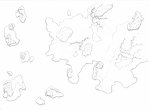Hey Everybody,
I'm quite new to D&D and have played it only a couple of times so far. However, I am interested in making my own campaign at some point in the future. So I read a lot and watched a ton of videos. Now I made a map by sticking to the advices of WASD20 on youtube. The only thing that really gives me headache is the map scale. Maybe some of you could take a look at it and suggest a reasonable scale that would make sense. Since I made this scan I inserted 7 citites throughout the whole map.
Thanks in advance.

I'm quite new to D&D and have played it only a couple of times so far. However, I am interested in making my own campaign at some point in the future. So I read a lot and watched a ton of videos. Now I made a map by sticking to the advices of WASD20 on youtube. The only thing that really gives me headache is the map scale. Maybe some of you could take a look at it and suggest a reasonable scale that would make sense. Since I made this scan I inserted 7 citites throughout the whole map.
Thanks in advance.

